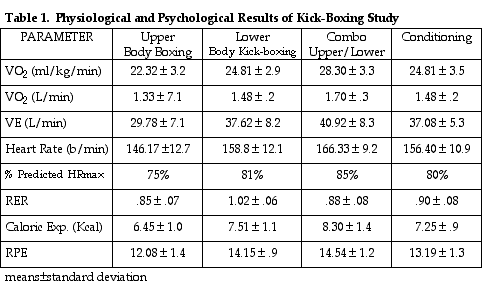| METABOLIC RESPONSE TO KICK-BOXING AEROBIC SEQUENCES IN WOMEN L. Kravitz, L. Green and J. Wongsathikun Group exercise is experiencing a kick-boxing phenomenon, due largely to a successful infomercial on this new exercise trend. This program involves variations of non-competitive boxing and kick-boxing styles integrated into a group exercise class format. Although some of these programs involve wearing boxing gloves and striking pads or bags, other programs involve performing the kicks and punches into the air as in shadow boxing. The purpose of this study was to examine the physiological and subjective responses of the shadow kick-boxing phenomenon to determine its efficacy as a new aerobic mode. A professionally trained boxer and martial artist (who is also an ACSM Certified Health and Fitness Instructor) choreographed and led four typical segments incorporated in a kick-boxing class: 1) upper body predominant, 2) lower body predominant, 3) combination of upper and lower body, and 4) conditioning (see Side Bar 1 for description of segments). Fifteen trained female (age = 24.7 ± 2.9 yr, height = 165.23 ± 7.0 cm, wt = 58.73 ± 9.6 kg) kick-boxing enthusiasts were recruited for this investigation. All subjects had participated in a minimum of 1 kick-boxing class per week for the last 6 months. Each of the four segments lasted two minutes, similar to the approximate amount of time usually spent on a sequence before changing to another movement series in a kick-boxing class. Oxygen consumption (VO2), ventilation (VE), and heart rate (HR) were monitored continuously during the four segments using open circuit spirometry and telemetry. Rating of perceived exertion (RPE) was recorded after each segment. Subjects rested a minimum of 2 minutes or until their heart rate was within 15 beats of their warm-up recovery heart rate before beginning the next sequence. |
 |
| Research Interests | | Vita | | Articles | | New Projects | | Miscellaneous | | UNM | | Home |